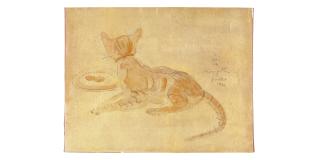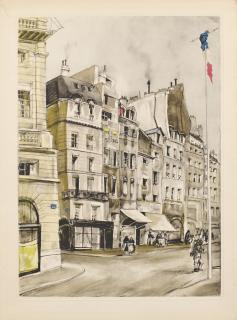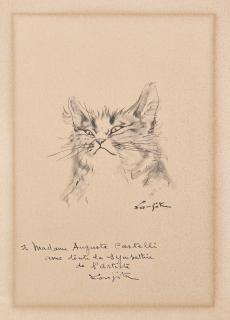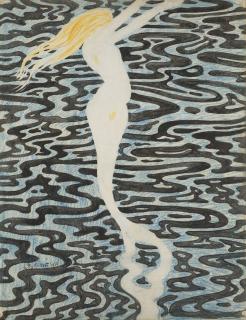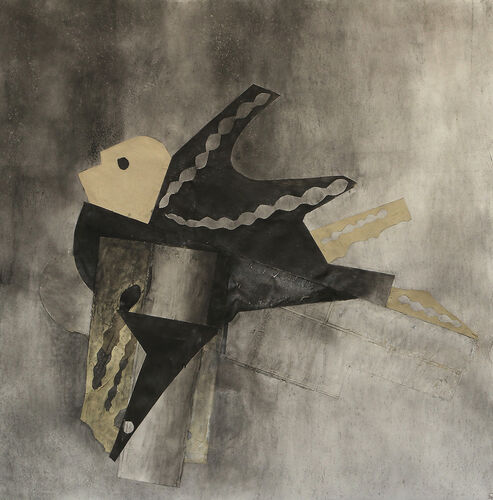
Leonard Tsuguharu Foujita
Deux Petites Filles
Found at
Christies,
Paris
Art Impressionniste & Moderne : OEuvres choisies, Lot 24
9. Apr - 9. Apr 2024
Art Impressionniste & Moderne : OEuvres choisies, Lot 24
9. Apr - 9. Apr 2024
Estimate: XX.XXX
Price realised: XX.XXX
Price realised: XX.XXX
Description
Après un service militaire d’une dizaine d’année au Japon en tant que peintre officiel de la Grande Guerre d’Asie, Foujita rentre à Paris en février 1950 et renoue enfin avec sa ville d’adoption. Il retrouve rapidement ses habitudes d’ancien ‘montparno’ et entame sa période dite de la renaissance parisienne. Les expositions se multiplient en France, chez Paul Pétridès notamment, mais aussi en Espagne et en Afrique du Nord.
Foujita regagne assez vite le succès qu’il avait connu avant la guerre pendant les années folles.
Pour décrire ces premiers tableaux parisiens d’après-guerre, Foujita s’exprime ainsi : « En réaction au temps de violence, j’ai imaginé des sujets très doux, très enfantins même ».
Deux Petites Filles sont caractéristiques de cette période de renaissance parisienne, période qui regroupe certaines des plus belles œuvre de l'artiste et reflète l’enchantement de Foujita pour Paris. Assises sur un balcon, arborant un léger sourire et vêtues de fines mousselines aux couleurs semblables à celle du drapeau français, les fillettes au teint de porcelaine paraissent songeuses. Le tableau est à la fois classique, notamment dans le choix d’une double construction pyramidale et des sujets - un clin d’œil direct aux maîtres italiens de la Renaissance - et moderne dans son traitement et son cadrage. Les toitures en zinc et en tuiles plates typiques du « Vieux-Paris » ont, par ailleurs, sans doute étaient inspirées des photographies d’Eugène Atget que Foujita collectionnait.
Avec ces Deux Petites Filles, Foujita mets également à l’honneur la notion japonaise et spirituelle de wabi-sabi (侘寂). Ce concept aux multiples significations, la plus courante étant de célébrer l’imperfection des choses vieillissantes voire modestes et déceler leur beauté grâce au travail du temps et des hommes, prend ici son toute son ampleur dans la technique employée par Foujita. En combinant sa maîtrise inégalée du dessin à l’encre et au pinceau à une ponctuation de touche de vernis par endroit, il créée un jeu de lumière et de patine particulier et engendre lui-même l’aspect vieillissant de la toile en vue de l’anoblir. Deux Petites Filles est un exemple typique de l’heureuse redécouverte de Paris par Foujita et de la richesse de ces influences occidentales et orientales.
After around ten years' military service in Japan as an official painter in the Great Asian War, Foujita returned to Paris in February 1950, finally reconnecting with his adopted city. He quickly rediscovered his old "Montparno" habits and began his period known as the Parisian renaissance. Exhibitions multiplied in France, notably with Paul Pétridès, but also in Spain and North Africa.
Foujita soon regained the success he had enjoyed before the war during the Roaring Twenties.
Describing these early post-war Parisian paintings, Foujita said: "In reaction to a time of violence, I imagined very gentle, even childlike subjects".Deux Petites Filles is characteristic of this period of Parisian renaissance, a period that brings together some of the artist's finest work and reflects Foujita's enchantment with Paris. Sitting on a balcony, smiling slightly and dressed in fine muslins in colours similar to those of the French flag, the porcelain-skinned girls appear pensive. The painting is both classical, particularly in its choice of double pyramid construction and subjects - a direct nod to the Italian masters of the Renaissance - and modern in its treatment and framing. The zinc and flat tile roofs typical of the 'Vieux-Paris' were no doubt inspired by the photographs of Eugène Atget that Foujita collected.
With these Deux Petites Filles, Foujita also gave pride of place to the Japanese spiritual notion of wabi-sabi (侘寂). This concept, with its many meanings - the most common of which is to celebrate the imperfection of things that are ageing or even modest, and to reveal their beauty through the work of time and people - takes on its full scope here in the technique employed by Foujita. By combining his unrivalled mastery of ink and brush drawing with a touch of varnish in places, he created a particular play of light and patina, himself creating the aged appearance of the canvas with a view to ennobling it. Deux Petites Filles is a typical example of Foujita's happy rediscovery of Paris and the richness of these Western and Eastern influences.
- Collection particulière, France (acquis auprès de l’artiste). | Puis par descendance au propriétaire actuel.
Foujita regagne assez vite le succès qu’il avait connu avant la guerre pendant les années folles.
Pour décrire ces premiers tableaux parisiens d’après-guerre, Foujita s’exprime ainsi : « En réaction au temps de violence, j’ai imaginé des sujets très doux, très enfantins même ».
Deux Petites Filles sont caractéristiques de cette période de renaissance parisienne, période qui regroupe certaines des plus belles œuvre de l'artiste et reflète l’enchantement de Foujita pour Paris. Assises sur un balcon, arborant un léger sourire et vêtues de fines mousselines aux couleurs semblables à celle du drapeau français, les fillettes au teint de porcelaine paraissent songeuses. Le tableau est à la fois classique, notamment dans le choix d’une double construction pyramidale et des sujets - un clin d’œil direct aux maîtres italiens de la Renaissance - et moderne dans son traitement et son cadrage. Les toitures en zinc et en tuiles plates typiques du « Vieux-Paris » ont, par ailleurs, sans doute étaient inspirées des photographies d’Eugène Atget que Foujita collectionnait.
Avec ces Deux Petites Filles, Foujita mets également à l’honneur la notion japonaise et spirituelle de wabi-sabi (侘寂). Ce concept aux multiples significations, la plus courante étant de célébrer l’imperfection des choses vieillissantes voire modestes et déceler leur beauté grâce au travail du temps et des hommes, prend ici son toute son ampleur dans la technique employée par Foujita. En combinant sa maîtrise inégalée du dessin à l’encre et au pinceau à une ponctuation de touche de vernis par endroit, il créée un jeu de lumière et de patine particulier et engendre lui-même l’aspect vieillissant de la toile en vue de l’anoblir. Deux Petites Filles est un exemple typique de l’heureuse redécouverte de Paris par Foujita et de la richesse de ces influences occidentales et orientales.
After around ten years' military service in Japan as an official painter in the Great Asian War, Foujita returned to Paris in February 1950, finally reconnecting with his adopted city. He quickly rediscovered his old "Montparno" habits and began his period known as the Parisian renaissance. Exhibitions multiplied in France, notably with Paul Pétridès, but also in Spain and North Africa.
Foujita soon regained the success he had enjoyed before the war during the Roaring Twenties.
Describing these early post-war Parisian paintings, Foujita said: "In reaction to a time of violence, I imagined very gentle, even childlike subjects".Deux Petites Filles is characteristic of this period of Parisian renaissance, a period that brings together some of the artist's finest work and reflects Foujita's enchantment with Paris. Sitting on a balcony, smiling slightly and dressed in fine muslins in colours similar to those of the French flag, the porcelain-skinned girls appear pensive. The painting is both classical, particularly in its choice of double pyramid construction and subjects - a direct nod to the Italian masters of the Renaissance - and modern in its treatment and framing. The zinc and flat tile roofs typical of the 'Vieux-Paris' were no doubt inspired by the photographs of Eugène Atget that Foujita collected.
With these Deux Petites Filles, Foujita also gave pride of place to the Japanese spiritual notion of wabi-sabi (侘寂). This concept, with its many meanings - the most common of which is to celebrate the imperfection of things that are ageing or even modest, and to reveal their beauty through the work of time and people - takes on its full scope here in the technique employed by Foujita. By combining his unrivalled mastery of ink and brush drawing with a touch of varnish in places, he created a particular play of light and patina, himself creating the aged appearance of the canvas with a view to ennobling it. Deux Petites Filles is a typical example of Foujita's happy rediscovery of Paris and the richness of these Western and Eastern influences.
- Collection particulière, France (acquis auprès de l’artiste). | Puis par descendance au propriétaire actuel.


